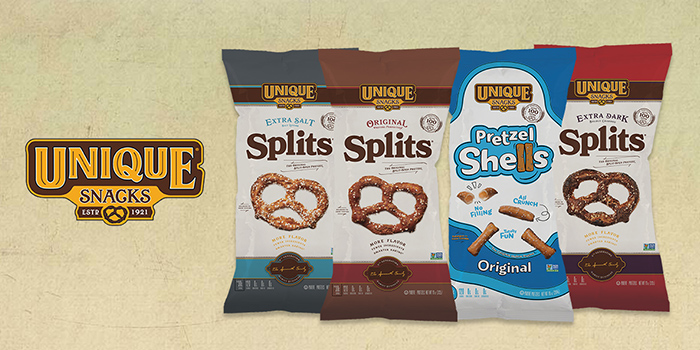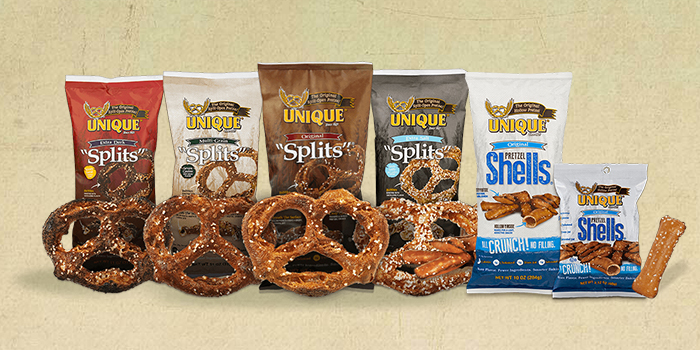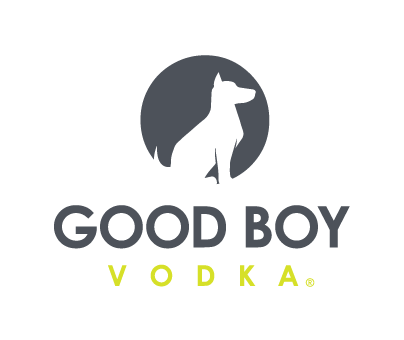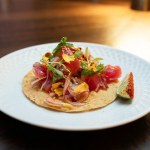Looking to Grow the Platform, Unique Pretzel Becomes Unique Snacks

It’s not that rare for a family business to rebrand, but Unique Pretzel has a pretty special story: pretzel makers since the 1700s, the Spannuth family launched commercial bakery Unique Pretzel Bakery in 1921. Based in Reading, Pennsylvania, the company’s chief product launched when William P. Spannuth (grandfather of current VPs Justin Spannuth, the company’s COO, and William Spannuth, its CFO) accidentally over-proofed a batch of pretzels and noticed that they split open on the outside, creating a distinct crunchy surface.
Now, the 100 year-old pretzel company is planning for a future beyond the salty snack staple. By February — its actual birthday — the company will have rebranded to Unique Snacks as it looks to launch into more salty snack categories. The rebrand was planned before the COVID-19 pandemic, but its rollout was halted by a few months as the company focused on meeting a spike in demand. Updated packaging will roll out in early 2021.
The company hasn’t innovated in a while: Unique Splits, the product of the accidental overproofing, debuted in stores in 1964. The company portfolio also includes other pretzel snacks including Shells, Rings and Sprouted Pretzels in 15,000 stores nationally including Whole Foods, Kroger and Wegmans. Over the last few years in particular, the brand’s footprint has grown significantly, reaching about 26% of conventional multi outlet (MULO) stores and 46% of natural stores in the U.S., according to Justin Spannuth.
Part of the move is designed to derisk its business and prepare for possible regulatory changes, Spannuth noted. For example, a current draft rule from the Food and Drug Administration (FDA) would voluntarily ask brands in some categories, such as pretzels, to reduce their sodium levels. Because the process for creating Splits involves more sodium than other pretzels, a category that already relies heavily on added salt, the company may need to change the recipe, which would require time and money.
There’s also potential for regulation around acrylamide, a chemical that forms during some high-temperature cooking, including pretzel-making. Although there are no current proposed changes from the FDA or U.S. Department of Agriculture (USDA), California is considering requiring a new warning on products containing the chemical.
Further regulatory changes, say, at the FDA or USDA level, could result in the company having to overhaul its production process to find a new way to bake pretzels, said Spannuth. Together, concerns about regulation were enough to inspire the company to consider other snack categories.
In expanding its lens, the company will also increase its manufacturing capabilities beyond its own existing plant, which would provide protection against market disruption due to natural disasters, Spannuth said.
Spannuth added that rather than offering niche items catering to special diets, Unique Snacks will instead focus on “selling to the masses,” developing cleaned-up, premium versions of conventional snacks. The company’s research found that customers are willing to spend more on “high-end” snacks even if they don’t have specific dietary benefits. There’s also potential to acquire brands, he added.
“We don’t want to ever go too far into left field, and we’re not just going to be flopping products out,” he said. “We want to stay and tow that line of ‘high-quality conventional’ with ‘mainstream natural.’”
With the brand’s established retailer relationships, future innovations can reach the market relatively quickly, he noted. The family-owned company has no plans to sell or take private equity funds. Buyers appreciate the company’s longevity and stability, he said.

Unique has had to rethink its business strategy before. With the 2007 economic crash, the company’s cost of goods soared at a time when 90% of its sales were in Eastern Pennsylvania and it had a direct store delivery (DSD) model. To survive, the company realized it needed to think about geographic expansion and rebranded to compete with conventional brands, increasing its pack size from 8 oz. to 11 oz., and adding a clear window and larger logo.
“We were a Pennsylvania Dutch bakery — a mom-and-pop looking company — and we were treated as such by buyers,” he said. “We looked like we were a regional brand [and] like we belonged in the region. We had a lot to learn really fast.”
Since then, the company has further adjusted its branding, ultimately removing the clear window and cutting back on copy while prioritizing the term “pretzels,” in case consumers were not familiar with the term Splits.
While new product launches, either developed in-house or by acquiring smaller brands, will be key, channel strategy will also be a priority. Due to the COVID-19 pandemic, in March and April, the company’s e-commerce sales grew 700% on Amazon and 300% on its own website. Now Unique Snacks needs to maintain some of this growth, Spannuth said.
Additionally, there’s still room to further push into conventional stores, he added, where the category continues to see strong returns. According to data firm IRI, dollar sales of pretzels grew 10% (more than $120 million) year-over-year to $1.4 billion for the 52 weeks ending Sept. 6. Spannuth said he believes this success is because pretzels dip into multiple segments and can appeal to a wide range of consumers.
“Pretzels really toe that line of falling in both worlds,” he said. “Your natural, healthier-conscious consumers will still eat a pretzel and then it still has that salt-satisfying, crave-satisfying on the other side.”
















